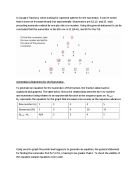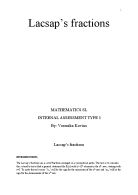Figure 3: Graph that plots the relation between row number and numerator
The graph above shows the relationship between the row numbers (1-5 on the x-axis) and the numerators (ranging from 1-15 on the y-axis). The row numbers and numerators increase at different rates, but both contribute to an ascending line, which looks as though it is half of a parabola. Based on this observation, the graph suggests that the general statement for Lacsap’s fractions is a quadratic equation: y = ax2 + bx + c. Although it would be simple to find out what this quadratic equation is by using a GDC, I have chosen to follow another route and find a different equation.
Since adding all of the numbers individually would take too much time, a general statement must be found to quicken the process. The same dilemma occurs when trying to figure out what the answer is when all the integers from 1 – 50 are added together. To avoid tallying all of the numbers together, it is much simpler to first add the first number (1) and the last number (50) together, which equals 51. When adding the second term (2) and the second-to-last term (49) together, the answer is also 51, because it is the sum of all the pairs in this number sequence. Considering that there are 25 of these pairs, one can calculate the answer by simply evaluating: 51 x 25 = 1,275. This exact situation can be applied to Lacsap’s fractions as well. Since the numerators increase by the term 1, is it natural to deduce that (n+1) is a part of the general statement. (n/2) is also a part of the equation because it represents how many pairs there are. The final equation looks like this:
Numerator= n2n+1 where n=row number
To test the general statement, the numerator of the 6th row will be found:
62 (6+1)=21
After finding the equation for the numerator, the equation for the denominator must also be found. The pattern that is noticeable in the denominators of Lacsap’s fractions is the difference between the numerator and the denominator in each consecutive fraction. In order to find the pattern for the denominator, the denominators will be categorized into the different elements and analyzed individually. The 1’s at the beginning of each sequence are not fractions, and thus are discarded for this investigation.
Table 2: Table that plots the difference of numerator and denominator and row number for the 1st element
For element 1 of Lacsap’s fractions, the difference between the numerator and the denominator increases constantly by 1. This means that some number always has to be subtracted from the numerator to attain the denominator (numerator – x = denominator). When observing the relationship between the row number and the difference between numerator and denominator, the table clearly indicates that the difference between the two is 1. This pattern sets up the initial equation:
Numerator-1n-1=Denominator where n = row number
Table 3: Table that plots the difference of numerator and denominator and row number for the 2nd element
For element 2, the differences are multiples of 2, contrasting with element 1. This means that everything has to be doubled, resulting in the equation:
Numerator-2n-2=Denominator
Table 4: Table that plots the difference of numerator and denominator and row number for the 3rd element
Similarly with element 3, the differences are multiples of 3, so the initial equation has to be tripled:
Numerator-3n-3=Denominator
The emergence of a pattern can be observed in those 3 equations. The numbers in each equation correspond to their respective element number, and thus are interchangeable parts. Using the format for the initial equation, r (element number) can be substituted for 1, which results in the equation:
Numerator-rn-r=Denominator
or n2(n+1)-rn-r=Denominator
Now, the equations for the numerator and the denominator can be combined to form a general statement, where n = row number and r = element:
En(r) =n2(n+1)n2(n+1)-r(n-r)
The general statement will be used for the first time to find the 6th and 7th rows. To find the sixth row, the row number will be plugged in for r and the element will be plugged in for n:
E61= 62(6+1)62(6+1)-1(6-1) E65= 62(6+1)62(6+1)-5(6-5)
After doing this for all the 5 elements in row 6, this is the result:
1 2116 2113 2112 2113 2116 1
The same procedure will be used in order to find the 7th row:
E71= 72(7+1)72(7+1)-1(7-1) E76= 72(7+1)72(7+1)-6(7-6)
This is what the 7th row looks like:
1 2821 2818 2816 2816 2818 2821 1
The 8th and 9th row will be found to further test the validity of the general statement:
E81= 82(8+1)82(8+1)-1(8-1) E87= 82(8+1)82(8+1)-7(8-7)
The result of the calculations for the 8th row:
1 3629 3624 3621 3620 3621 3624 3629 1
The 9th row will be found in the same manner:
E91= 92(9+1)92(9+1)-1(9-1) E98= 92(9+1)92(9+1)-8(9-8)
The 9th row:
1 4537 4531 4527 4525 4525 4527 4531 4537 1
During the investigation, the 1’s at the beginning and end of each row were not included in the calculations because they were not fractions. This means that the 1st element of each row was actually the “second” number, because the 1’s were ignored. Therefore, the general statement cannot be used to calculate anything in the first row of Lacsap’s fractions, because that row is composed of two 1’s. Additionally, the general statement is limited to numbers from the set of natural numbers, meaning that they must be integers and positive. Negative, rational and irrational numbers will not yield any results because Lacsap’s fractions starts with the number 1, and any number below that or deviating from that form will not fit the criteria. Apart from these limitations, any row of Lacsap’s fractions can be calculated using this general statement.
Image taken from: <http://www.thirteen.org/edonline/nttidb/lessons/as/buildasw.html>, May 9th, 2012








